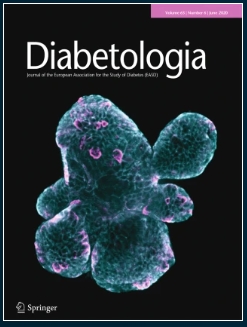妊娠早期OGTT和生物标志物在妊娠糖尿病发展中的应用:一项国际前瞻性多中心队列研究。
IF 10.2
1区 医学
Q1 ENDOCRINOLOGY & METABOLISM
引用次数: 0
摘要
目的/假设对于妊娠早期晚期发展为妊娠期糖尿病(GDM)的准确风险分层尚无明确的共识。因此,本研究旨在评估OGTT和几种生物标志物在妊娠前三个月的预测性能。它们与胰岛素作用、β细胞功能和胰岛素需求的关系也被进一步评估。方法在这项前瞻性队列研究中,我们纳入了6个中欧中心的657名孕妇。获得患者病史和人体测量数据,在中位胎龄13.4周(IQR 12.7-14.1)时进行75 g OGTT盲法检查和生化指标评估。在妊娠后期进行另一次OGTT以确定患有GDM的妇女。在两次访问中,对一组妇女进行了葡萄糖稳态的详细调查。结果83例(12.6%)发生GDM。根据受试者工作特征曲线下的面积,OGTT早期的葡萄糖浓度可以很好地预测GDM的进展(OGTT空腹血糖:0.68;60分钟OGTT葡萄糖:0.74;120分钟OGTT葡萄糖:0.72)。一些生物标志物显示出显著但适度的预测准确性。妊娠早期OGTT葡萄糖浓度进一步与胰岛素敏感性受损和β细胞功能障碍以及妊娠后期对胰岛素的需求相关。结论/解释尽管24周前GDM的准确诊断仍在讨论中,但早期OGTT期间动态评估的葡萄糖浓度与葡萄糖稳态受损密切相关,并且对GDM的后期发展以及胰岛素需求具有良好的预测准确性。这些发现可能用于制定一项区分低风险母亲和高风险母亲的方案。临床试验注册:ClinicalTrials.gov NCT02035059。本文章由计算机程序翻译,如有差异,请以英文原文为准。
The utility of early gestational OGTT and biomarkers for the development of gestational diabetes mellitus: an international prospective multicentre cohort study.
AIMS/HYPOTHESIS
There is no clear consensus regarding accurate risk stratification in early pregnancy for later developing gestational diabetes mellitus (GDM). Therefore, this study aims to evaluate the predictive performance of an OGTT and several biomarkers in the first trimester of pregnancy. Their association with insulin action, beta cell function and requirement for insulin were additionally assessed.
METHODS
In this prospective cohort study, we included 657 pregnant women in six Central European centres. Patient history and anthropometric data were obtained, a blinded 75 g OGTT was performed and biochemical markers were assessed at a median gestational age of 13.4 weeks (IQR 12.7-14.1). Another OGTT was performed in later pregnancy to identify women with GDM. A detailed investigation of glucose homeostasis was performed at both visits in a subgroup of women.
RESULTS
Eighty-three women (12.6%) developed GDM. Progression to GDM was fairly well predicted by glucose concentrations during the early OGTT in terms of areas under the receiver operating characteristic curves (OGTT glucose at fasting: 0.68; OGTT glucose at 60 min: 0.74; OGTT glucose at 120 min: 0.72). Some biomarkers showed significant but modest predictive accuracy. Early gestational OGTT glucose concentrations were further associated with impaired insulin sensitivity and beta cell dysfunction, as well as the requirement for insulin in later pregnancy.
CONCLUSIONS/INTERPRETATION
Although the accurate diagnosis of GDM before 24 weeks remains an ongoing discussion, dynamically assessed glucose concentrations during an early OGTT were closely associated with impaired glucose homeostasis and showed good predictive accuracy for later development of GDM as well as the requirement for insulin. These findings may be used to develop a protocol to distinguish between low- and high-risk mothers. Trial registration ClinicalTrials.gov NCT02035059.
求助全文
通过发布文献求助,成功后即可免费获取论文全文。
去求助
来源期刊

Diabetologia
医学-内分泌学与代谢
CiteScore
18.10
自引率
2.40%
发文量
193
审稿时长
1 months
期刊介绍:
Diabetologia, the authoritative journal dedicated to diabetes research, holds high visibility through society membership, libraries, and social media. As the official journal of the European Association for the Study of Diabetes, it is ranked in the top quartile of the 2019 JCR Impact Factors in the Endocrinology & Metabolism category. The journal boasts dedicated and expert editorial teams committed to supporting authors throughout the peer review process.
 求助内容:
求助内容: 应助结果提醒方式:
应助结果提醒方式:


